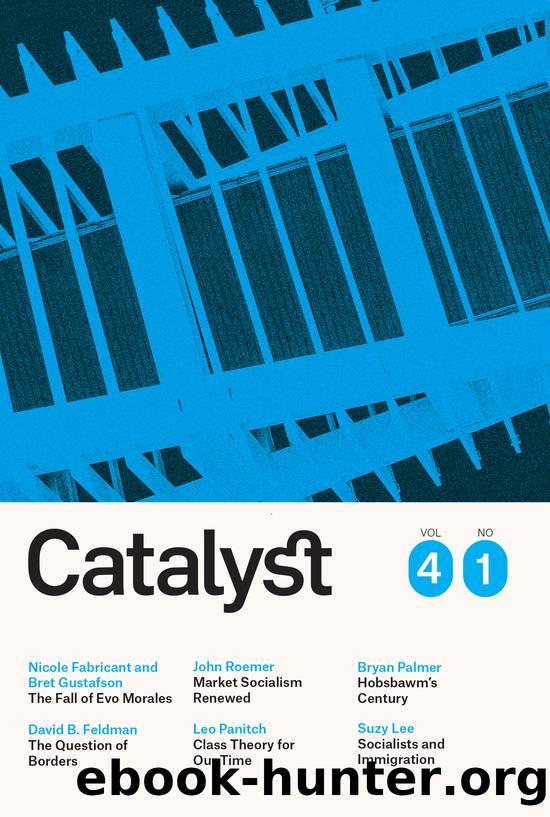Vol 4 â Issue 1 by Catalyst

Author:Catalyst
Language: eng
Format: epub
Published: 2022-08-25T20:36:38+00:00
The Political Economy of Right-Wing Pragmatism
The complexity of this upheaval requires going beyond simplistic narratives about grabs for gas, lithium, or some other valuable resource. Although the putsch must be described as a coup, it is important to understand how political and economic factors shaped the conditions for its success and weakened the prospects for mounting an effective popular resistance. While the international left correctly expressed outrage at the coup, many Bolivian leftists have rejected the coup narrative and refused to blindly defend the Morales government. This is, in part, due to electoral irregularities under his watch and his obstinate insistence on staying in power, but it was more centrally because of the degradation of crucial components of the original MAS political project, which we describe further below. The possibilities for radical and progressive change were constrained by economic structures â some of which were reproduced by MAS policy decisions, others as the result of the MASâs relative weakness in the face of global capital. These constraints cannot be reduced to Morales alone, but they speak to a failure to transform the structure of the economy, still largely dependent on gas, mining, and soy.
The process of change (proceso de cambio) that took place under Evo Morales was, in part, driven by the return of the stateâs role in the economy, a new constitution that enshrined political rights for indigenous peoples, and redistribution of resource wealth. Shaped largely by older paradigms of the nationalist left, the government framed this process as part of a historical project of decolonization to end centuries of racism and marginalization of Boliviaâs indigenous and peasant populations. In 2009, Bolivians ratified a new constitution that claimed to ârefoundâ Bolivia as a âplurinationalâ state, promising improvements in indigenous rights while enshrining social rights to health care, education, housing, and water to the entire population.6 In public discourse, Morales and MAS officials spoke of the pursuit of a âgood lifeâ (buen vivir), promising to dismantle the orthodox neoliberal capitalism that had dominated Bolivian politics since 1985. In addition, Morales promised economic development in harmony with nature.
The MASâs alternative to the conventional neoliberal economic model was called an âEconomic, Social, Communitarian, and Productive Modelâ (Modelo económico, social, comunitario y productivo). This plan initially included the redistribution of lands and the provision of critical resources such as tools, machinery, and expertise to small-scale producers, mainly in the East. Its intention was twofold: 1) to make the Bolivian economy less dependent on the industrial agribusiness model, and 2) to free Bolivia from its dependence on raw material exports by transferring the profits from surpluses in mining, hydrocarbons, and electricity exports â channeled through the state â into other, more labor-intensive sectors, including manufacturing, tourism, and agrarian development.7 These policies led to an increase in rents and royalties channeled into the national treasury, much of it from natural gas exports, but also linked the process of change ever more firmly to capitalist hydrocarbon markets and actors. Paradoxically, Boliviaâs progressive nationalist turn required an embrace and entrenchment of extractive industries, and, in particular, natural gas.
Download
This site does not store any files on its server. We only index and link to content provided by other sites. Please contact the content providers to delete copyright contents if any and email us, we'll remove relevant links or contents immediately.
Fangirl by Rainbow Rowell(9034)
How to Bang a Billionaire by Alexis Hall(8041)
Wonder by R. J. Palacio(7880)
The Space Between by Michelle L. Teichman(6818)
The Thirst by Nesbo Jo(6769)
Assassin’s Fate by Robin Hobb(6063)
Wiseguy by Nicholas Pileggi(5618)
The Night Circus by Erin Morgenstern(5113)
The Kite Runner by Khaled Hosseini(5045)
Paper Towns by Green John(5030)
Bittersweet (True North #1) by Sarina Bowen(4764)
Gerald's Game by Stephen King(4521)
Too Much and Not the Mood by Durga Chew-Bose(4237)
Pillow Thoughts by Courtney Peppernell(4179)
Goodbye Paradise(3672)
Twelve Days of Christmas by Debbie Macomber(3471)
Good by S. Walden(3456)
The Rosie Effect by Graeme Simsion(3336)
The Cellar by Natasha Preston(3225)
